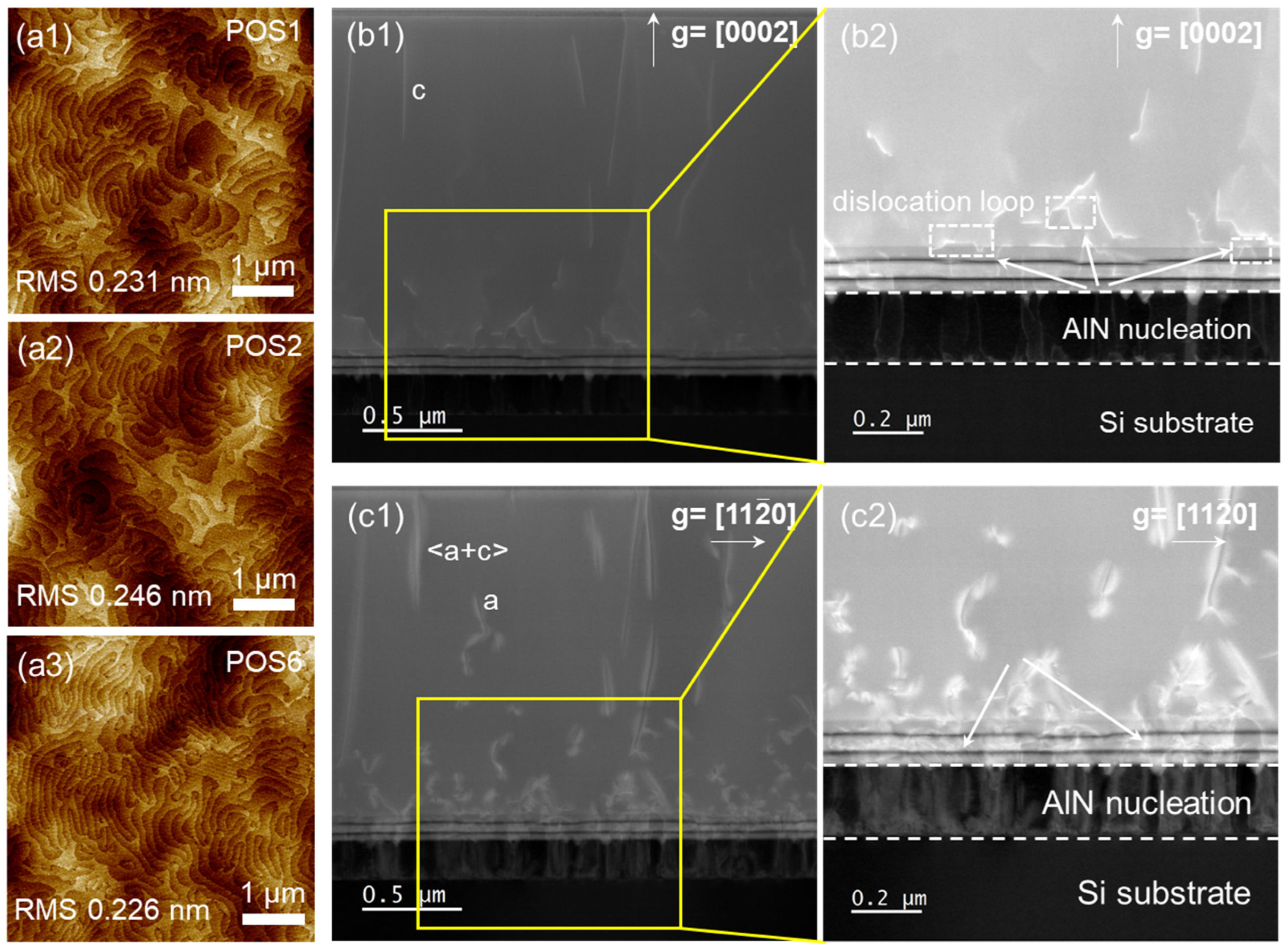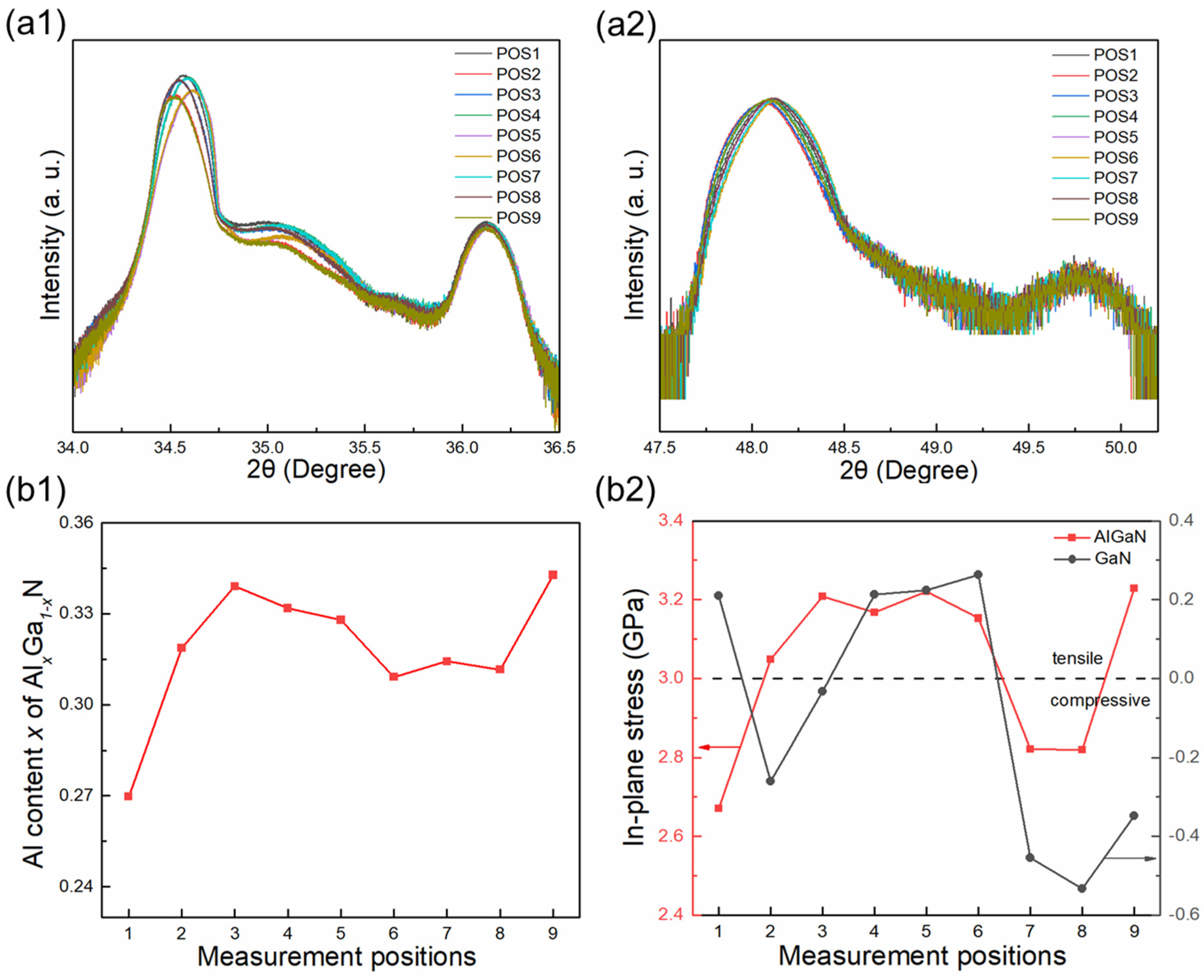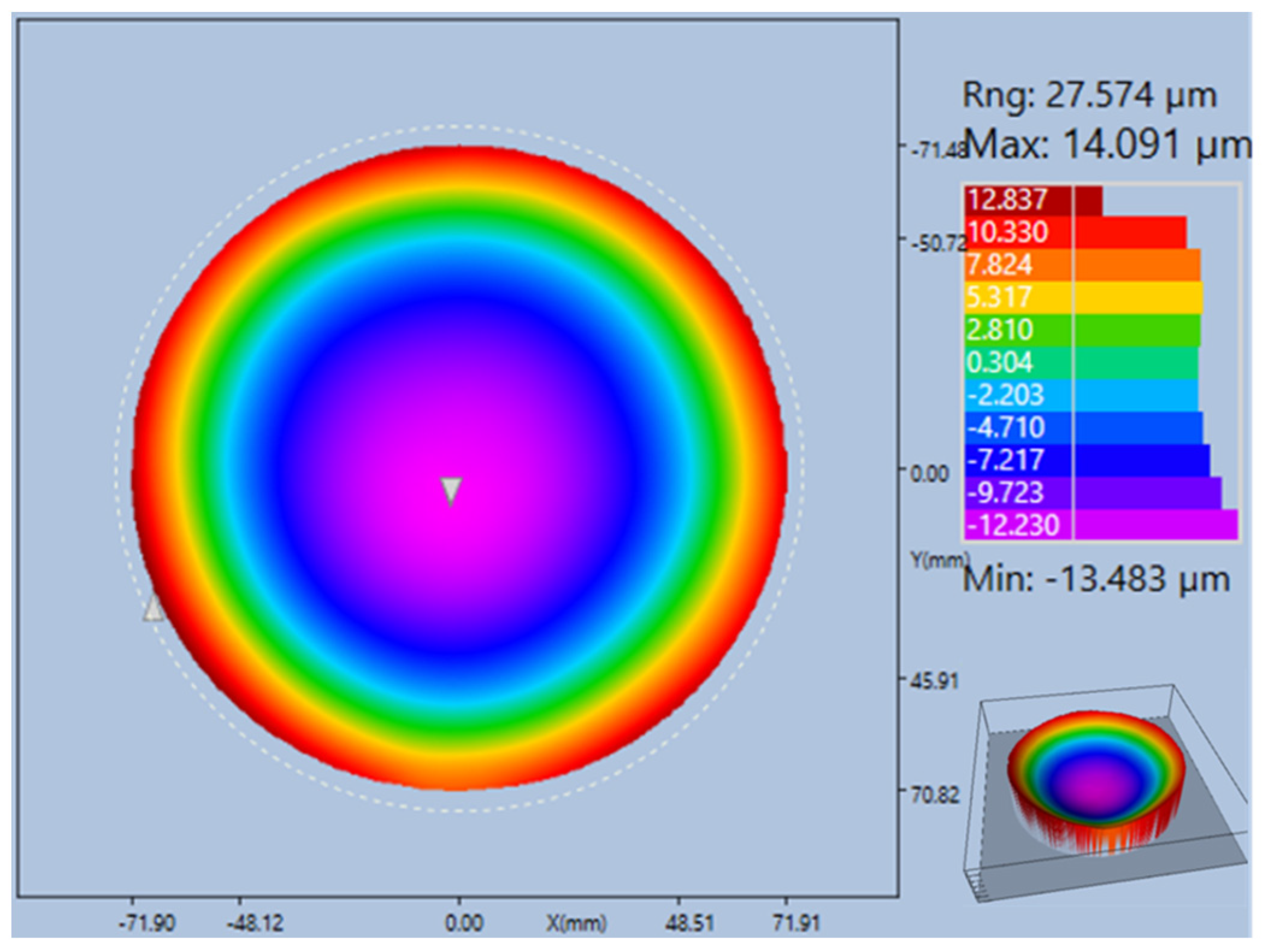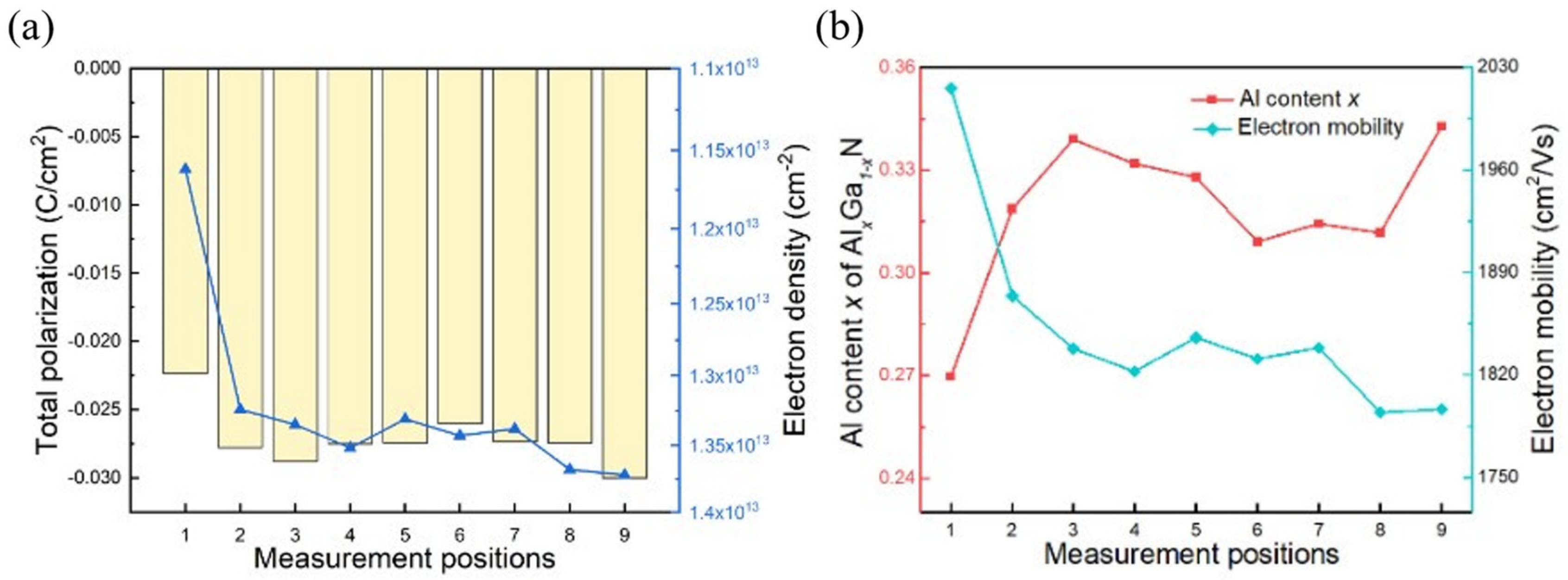The Effect of the Barrier Layer on the Uniformity of the Transport Characteristics of AlGaN/GaN Heterostructures on HR-Si(111)
Abstract
:1. Introduction
2. Experimental Details
3. Results and Discussion
4. Conclusions
Author Contributions
Funding
Data Availability Statement
Conflicts of Interest
References
- Mishra, U.K.; Shen, L.; Kazior, T.E.; Yi-Feng, W. GaN-Based RF Power Devices and Amplifiers. Proc. IEEE 2008, 96, 287–305. [Google Scholar] [CrossRef]
- Lev, L.L.; Maiboroda, I.O.; Husanu, M.A.; Grichuk, E.S.; Chumakov, N.K.; Ezubchenko, I.S.; Chernykh, I.A.; Wang, X.; Tobler, B.; Schmitt, T.; et al. k-space imaging of anisotropic 2D electron gas in GaN/GaAlN high-electron-mobility transistor heterostructures. Nat. Commun. 2018, 9, 2653. [Google Scholar] [CrossRef] [PubMed]
- Zheng, Z.; Zhang, L.; Song, W.; Feng, S.; Xu, H.; Sun, J.; Yang, S.; Chen, T.; Wei, J.; Chen, K.J. Gallium nitride-based complementary logic integrated circuits. Nat. Electron. 2021, 4, 595–603. [Google Scholar] [CrossRef]
- Zeng, F.; An, J.; Zhou, G.; Li, W.; Wang, H.; Duan, T.; Jiang, L.; Yu, H. A Comprehensive Review of Recent Progress on GaN High Electron Mobility Transistors: Devices, Fabrication and Reliability. Electronics 2018, 7, 377. [Google Scholar] [CrossRef]
- Wang, P.F.; Li, X.; Zhang, E.X.; Jiang, R.; McCurdy, M.W.; Poling, B.S.; Heller, E.R.; Schrimpf, R.D.; Fleetwood, D.M. Worst-Case Bias for High Voltage, Elevated-Temperature Stress of AlGaN/GaN HEMTs. IEEE Trans. Device Mater. Reliab. 2020, 20, 420–428. [Google Scholar] [CrossRef]
- Li, X.; Wang, P.F.; Zhao, X.; Qiu, H.; Gorchichko, M.; McCurdy, M.W.; Schrimpf, R.D.; Zhang, E.X.; Fleetwood, D.M. Defect and Impurity-Center Activation and Passivation in Irradiated AlGaN/GaN HEMTs. IEEE Trans. Nucl. Sci. 2024, 71, 80–87. [Google Scholar] [CrossRef]
- Huang, H.; Li, F.; Sun, Z.; Cao, Y. Model Development for Threshold Voltage Stability Dependent on High Temperature Operations in Wide-Bandgap GaN-Based HEMT Power Devices. Micromachines 2018, 9, 658. [Google Scholar] [CrossRef]
- Yu, E.T.; Sullivan, G.J.; Asbeck, P.M.; Wang, C.D.; Qiao, D.; Lau, S.S. Measurement of piezoelectrically induced charge in GaN/AlGaN heterostructure field-effect transistors. Appl. Phys. Lett. 1997, 71, 2794–2796. [Google Scholar] [CrossRef]
- Gaska, R.; Yang, J.W.; Bykhovski, A.D.; Shur, M.S.; Kaminski, V.V.; Soloviov, S.M. The influence of the deformation on the two-dimensional electron gas density in GaN–AlGaN heterostructures. Appl. Phys. Lett. 1998, 72, 64–66. [Google Scholar] [CrossRef]
- Kobayashi, Y.; Kumakura, K.; Akasaka, T.; Makimoto, T. Layered boron nitride as a release layer for mechanical transfer of GaN-based devices. Nature 2012, 484, 223–227. [Google Scholar] [CrossRef]
- Liu, F.; Zhang, Z.; Rong, X.; Yu, Y.; Wang, T.; Sheng, B.; Wei, J.; Zhou, S.; Yang, X.; Xu, F.; et al. Graphene-Assisted Epitaxy of Nitrogen Lattice Polarity GaN Films on Non-Polar Sapphire Substrates for Green Light Emitting Diodes. Adv. Funct. Mater. 2020, 30, 2001283. [Google Scholar] [CrossRef]
- Yu, Y.; Wang, T.; Chen, X.; Zhang, L.; Wang, Y.; Niu, Y.; Yu, J.; Ma, H.; Li, X.; Liu, F.; et al. Demonstration of epitaxial growth of strain-relaxed GaN films on graphene/SiC substrates for long wavelength light-emitting diodes. Light Sci. Appl. 2021, 10, 117. [Google Scholar] [CrossRef]
- Rongming, C.; Corrion, A.; Chen, M.; Ray, L.; Wong, D.; Zehnder, D.; Hughes, B.; Boutros, K. 1200-V Normally Off GaN-on-Si Field-Effect Transistors With Low Dynamic on -Resistance. IEEE Electron Device Lett. 2011, 32, 632–634. [Google Scholar] [CrossRef]
- Chen, K.J.; Haberlen, O.; Lidow, A.; Tsai, C.l.; Ueda, T.; Uemoto, Y.; Wu, Y. GaN-on-Si Power Technology: Devices and Applications. IEEE Trans. Electron Devices 2017, 64, 779–795. [Google Scholar] [CrossRef]
- Lu, H.; Hou, B.; Yang, L.; Zhang, M.; Deng, L.; Wu, M.; Si, Z.; Huang, S.; Ma, X.; Hao, Y. High RF Performance GaN-on-Si HEMTs With Passivation Implanted Termination. IEEE Electron Device Lett. 2022, 43, 188–191. [Google Scholar] [CrossRef]
- Dadgar, A. Sixteen years GaN on Si. Phys. Status Solidi B 2015, 252, 1063–1068. [Google Scholar] [CrossRef]
- Krost, A.; Dadgar, A.; Strassburger, G.; Clos, R. GaN-based epitaxy on silicon: Stress measurements. Phys. Stat. Sol. (A) 2003, 200, 26–35. [Google Scholar] [CrossRef]
- Ma, J.; Zhang, Y.; Yao, Y.; Zhang, T.; Li, Y.; Feng, Q.; Bi, Z.; Zhang, J.; Hao, Y. Effects of Al Preflow on the Uniformity of an AlN Nucleation Layer and GaN Grown on Si (111) Substrate. J. Electron. Mater. 2022, 51, 3342–3349. [Google Scholar] [CrossRef]
- Chen, P.; Zhang, R.; Zhao, Z.; Xi, D.; Shen, B.; Chen, Z.; Zhou, Y.; Xie, S.; Lu, W.; Zheng, Y. Growth of high quality GaN layers with AlN buffer on Si(111) substrates. J. Cryst. Growth 2001, 225, 150–154. [Google Scholar] [CrossRef]
- Wang, K.; Xing, Y.; Han, J.; Zhao, K.; Guo, L.; Zhang, Y.; Deng, X.; Fan, Y.; Zhang, B. Influence of the TMAl source flow rate of the high temperature AlN buffer on the properties of GaN grown on Si(111) substrate. J. Alloys Compd. 2016, 671, 435–439. [Google Scholar] [CrossRef]
- Ni, Y.; He, Z.; Yang, F.; Zhou, D.; Yao, Y.; Zhou, G.; Shen, Z.; Zhong, J.; Zhen, Y.; Wu, Z.; et al. Effect of AlN/GaN superlattice buffer on the strain state in GaN-on-Si(111) system. Jpn. J. Appl. Phys. 2015, 54, 015505. [Google Scholar] [CrossRef]
- Lin, P.; Huang, S.; Wang, W.; Chen, C.; Chung, B.; Wuu, D. Controlling the stress of growing GaN on 150-mm Si (111) in an AlN/GaN strained layer superlattice. Appl. Surf. Sci. 2016, 362, 434–440. [Google Scholar] [CrossRef]
- Cheng, K.; Leys, M.; Degroote, S.; Van Daele, B.; Boeykens, S.; Derluyn, J.; Germain, M.; Van Tendeloo, G.; Engelen, J.; Borghs, G. Flat GaN epitaxial layers grown on Si (111) by metalorganic vapor phase epitaxy using step-graded AlGaN intermediate layers. J. Electron. Mater. 2006, 35, 592–598. [Google Scholar] [CrossRef]
- Xiang, R.F.; Fang, Y.Y.; Dai, J.N.; Zhang, L.; Su, C.Y.; Wu, Z.H.; Yu, C.H.; Xiong, H.; Chen, C.Q.; Hao, Y. High quality GaN epilayers grown on Si (111) with thin nonlinearly composition-graded AlxGa1−xN interlayers via metal-organic chemical vapor deposition. J. Alloys Compd. 2011, 509, 2227–2231. [Google Scholar] [CrossRef]
- Mansor, M.; Norhaniza, R.; Shuhaimi, A.; Hisyam, M.I.; Omar, A.Z.; Williams, A.; Mat Hussin, M.R. Enhancement of gallium nitride on silicon (111) using pulse atomic-layer epitaxy (PALE) AlN with composition-graded AlGaN buffer. Sci. Rep. 2023, 13, 8793. [Google Scholar] [CrossRef] [PubMed]
- Cheng, J.; Yang, X.; Sang, L.; Guo, L.; Zhang, J.; Wang, J.; He, C.; Zhang, L.; Wang, M.; Xu, F.; et al. Growth of high quality and uniformity AlGaN/GaN heterostructures on Si substrates using a single AlGaN layer with low Al composition. Sci. Rep. 2016, 6, 23020. [Google Scholar] [CrossRef] [PubMed]
- Lee, H.P.; Perozek, J.; Rosario, L.D.; Bayram, C. Investigation of AlGaN/GaN high electron mobility transistor structures on 200-mm silicon (111) substrates employing different buffer layer configurations. Sci. Rep. 2016, 6, 37588. [Google Scholar] [CrossRef] [PubMed]
- Razeen, A.S.; Yuan, G.; Ong, J.; Kim Hui, H.; Radhakrishnan, K.; Tripathy, S. Structural, optical, and electrical characterization and performance comparison of AlGaN/GaN HEMT structures with different buffer layers. Vacuum 2024, 219, 112704. [Google Scholar] [CrossRef]
- Ma, J.; Zhang, Y.; Li, Y.; Zhang, T.; Yao, Y.; Feng, Q.; Bi, Z.; Zhang, J.; Hao, Y. Mechanistic influence on uniformity of sheet resistance of AlGaN/GaN HEMT grown on Si substrate with the graded AlGaN buffer layers. Vacuum 2022, 199, 110966. [Google Scholar] [CrossRef]
- Katz, O.; Horn, A.; Bahir, G.; Salzman, J. Electron mobility in an AlGaN/GaN two-dimensional electron gas I-carrier concentration dependent mobility. IEEE Trans. Electron Devices 2003, 50, 2002–2008. [Google Scholar] [CrossRef]
- Lange, A.P.; Mahajan, S. Influence of trimethylaluminum predoses on the growth morphology, film-substrate interface, and microstructure of MOCVD-grown AlN on (111)Si. J. Cryst. Growth 2019, 511, 106–117. [Google Scholar] [CrossRef]
- Kadir, A.; Huang, C.C.; Kian Lee, K.E.; Fitzgerald, E.A.; Chua, S.J. Determination of alloy composition and strain in multiple AlGaN buffer layers in GaN/Si system. Appl. Phys. Lett. 2014, 105, 232113. [Google Scholar] [CrossRef]
- Waseda, Y.; Matsubara, E.; Shinoda, K. X-ray Diffraction Crystallography: Introduction, Examples and Solved Problems; Springer: Berlin/Heidelberg, Germany, 2011. [Google Scholar]
- Foronda, H.M.; Mazumder, B.; Young, E.C.; Laurent, M.A.; Li, Y.; DenBaars, S.P.; Speck, J.S. Analysis of Vegard’s law for lattice matching InxAl1−xN to GaN by metalorganic chemical vapor deposition. J. Cryst. Growth 2017, 475, 127–135. [Google Scholar] [CrossRef]
- Chen, Z.; Pei, Y.; Newman, S.; Brown, D.; Chung, R.; Keller, S.; DenBaars, S.P.; Nakamura, S.; Mishra, U.K. Growth of AlGaN/GaN/AlGaN double heterojunction field-effect transistors and the observation of a compositional pulling effect. Appl. Phys. Lett. 2009, 94, 171117. [Google Scholar] [CrossRef]
- Moram, M.A.; Vickers, M.E. X-ray diffraction of III-nitrides. Rep. Prog. Phys. 2009, 72, 036502. [Google Scholar] [CrossRef]
- Gleize, J.; Demangeot, F.; Frandon, J.; Renucci, M.A.; Widmann, F.; Daudin, B. Phonons in a strained hexagonal GaN–AlN superlattice. Appl. Phys. Lett. 1999, 74, 703–705. [Google Scholar] [CrossRef]
- Ambacher, O.; Smart, J.; Shealy, J.R.; Weimann, N.G.; Chu, K.; Murphy, M.; Schaff, W.J.; Eastman, L.F.; Dimitrov, R.; Wittmer, L.; et al. Two-dimensional electron gases induced by spontaneous and piezoelectric polarization charges in N- and Ga-face AlGaN/GaN heterostructures. J. Appl. Phys. 1999, 85, 3222–3233. [Google Scholar] [CrossRef]
- Demir, M.; Yarar, Z.; Ozdemir, M. Effect of polarization and interface roughness on the transport properties of AlGaN/GaN heterostructure. Solid State Commun. 2013, 158, 29–33. [Google Scholar] [CrossRef]








| Measurement Locations | (002) FWHM (Arcsec) | (102) FWHM (Arcsec) |
|---|---|---|
| 1 | 505.91 | 809.93 |
| 2 | 515.48 | 795.78 |
| 3 | 516.17 | 794.99 |
| 4 | 516.02 | 798.84 |
| 5 | 516.60 | 795.24 |
| 6 | 513.14 | 788.98 |
| 7 | 509.94 | 786.17 |
| 8 | 514.80 | 786.60 |
| 9 | 514.40 | 790.31 |
| GaN | AlN | AlxGa1−xN | ||
|---|---|---|---|---|
| Piezoelectric coefficients (C/m2) | e31 | −0.49 | −0.6 | −0.49 − 0.11x |
| e33 | 0.73 | 1.46 | 0.73 + 0.73x | |
| Elastic constants (Gpa) | C11 | 367 | 396 | 367 + 29x |
| C12 | 135 | 137 | 135 + 2x | |
| C13 | 105 | 108 | 103 + 5x | |
| C33 | 405 | 373 | 405 − 32x | |
| Spontaneous polarization (C/m2) | PSP | −0.029 | −0.081 | −0.052x − 0.029 |
Disclaimer/Publisher’s Note: The statements, opinions and data contained in all publications are solely those of the individual author(s) and contributor(s) and not of MDPI and/or the editor(s). MDPI and/or the editor(s) disclaim responsibility for any injury to people or property resulting from any ideas, methods, instructions or products referred to in the content. |
© 2024 by the authors. Licensee MDPI, Basel, Switzerland. This article is an open access article distributed under the terms and conditions of the Creative Commons Attribution (CC BY) license (https://creativecommons.org/licenses/by/4.0/).
Share and Cite
Yan, Y.; Liu, Y.; Xiong, G.; Huang, J.; Yang, B. The Effect of the Barrier Layer on the Uniformity of the Transport Characteristics of AlGaN/GaN Heterostructures on HR-Si(111). Micromachines 2024, 15, 536. https://doi.org/10.3390/mi15040536
Yan Y, Liu Y, Xiong G, Huang J, Yang B. The Effect of the Barrier Layer on the Uniformity of the Transport Characteristics of AlGaN/GaN Heterostructures on HR-Si(111). Micromachines. 2024; 15(4):536. https://doi.org/10.3390/mi15040536
Chicago/Turabian StyleYan, Yujie, Yangbowen Liu, Guodong Xiong, Jun Huang, and Bing Yang. 2024. "The Effect of the Barrier Layer on the Uniformity of the Transport Characteristics of AlGaN/GaN Heterostructures on HR-Si(111)" Micromachines 15, no. 4: 536. https://doi.org/10.3390/mi15040536





